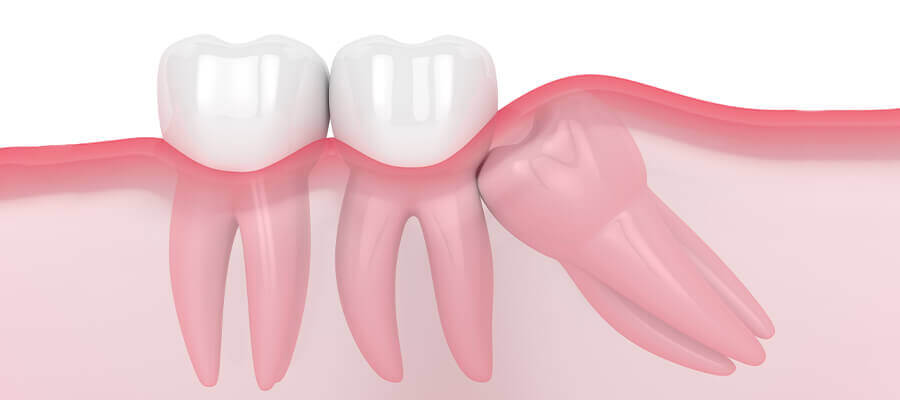The name “wisdom tooth” comes from the fact that it typically emerges later, usually between the ages of 16 and 25. It is the last tooth in the dental arch, and there are two of them per jaw (one on each side, both upper and lower). However, it is not uncommon for them not to erupt at all.

Why might wisdom tooth extraction be necessary?
While some people’s wisdom teeth erupt without any issues, it is common for the wisdom tooth to encounter obstacles during the eruption process simply because there is not enough space for proper development.

- In such cases, the following problems can occur with the affected tooth:
- It grows at an angle toward the adjacent tooth.
- It grows at an angle toward the back of the mouth.
- It grows in a way that appears to “rest” on the jawbone.
- It starts growing at the right angle but gets trapped within the jawbone.
Any of these situations may warrant the removal of the wisdom tooth.

When is it necessary to remove a wisdom tooth?
The above-mentioned problems may initially be asymptomatic. However, certain symptoms clearly indicate the need for wisdom tooth extraction:
- Pain
- Trapped food debris behind the wisdom tooth
- Infection or gum disease
- Tooth decay in the partially erupted wisdom tooth
- Injury to a neighboring tooth or bone
- Cyst around the wisdom tooth
- Complications related to orthodontic treatment involving other teeth

What should you do if the wisdom tooth does not cause any symptoms?
Experts’ opinions may vary on whether it is necessary to remove a symptom-free but impacted wisdom tooth. In such cases, the following factors should be considered:
- The currently asymptomatic tooth may cause problems later.
- If there is insufficient space for the tooth to erupt, it is usually challenging to keep it clean, increasing the risk of tooth decay.
- Serious symptoms are more common in older age.
- Recovery after surgery may be slower in older age.
- How is wisdom tooth extraction performed?
The oral surgery procedure can be done under local anesthesia or general anesthesia, primarily depending on the patient’s preferences. The oral surgeon makes an incision in the gum tissue to access the tooth and bone and removes the bone that hinders access to the wisdom tooth’s roots. Then, the affected tooth is sectioned to facilitate its removal. After extraction, the socket is thoroughly cleaned. Suturing the wound may promote healing, but it is not always necessary. Finally, gauze is placed in the socket to reduce bleeding and promote blood clotting.

After wisdom tooth extraction
Following oral surgery performed with the utmost expertise and precision, it is crucial to strictly follow the medical instructions, which contribute to smooth healing and minimize the risk of complications.

Bleeding is normal after wisdom tooth extraction, and it can be alleviated by replacing the gauze at recommended intervals and avoiding exertion (e.g., vigorous spitting). Pain management at home can be achieved with prescribed or over-the-counter medication following the instructions, especially if bone removal was necessary. Swelling that may last for a few days can be relieved by applying ice packs.

Normal daily activities can generally be resumed the day after the procedure, excluding physically demanding work or exercise, which should be avoided for at least a week. Consuming alcoholic, caffeinated, carbonated, or hot beverages is not recommended during the initial stage of recovery. In the first 24 hours, it is advisable to stick to softer foods, as hard, spicy, or hot foods can irritate the surgical site. Brushing the teeth can usually be resumed after 24 hours, taking into account the sensitivity of the affected area.